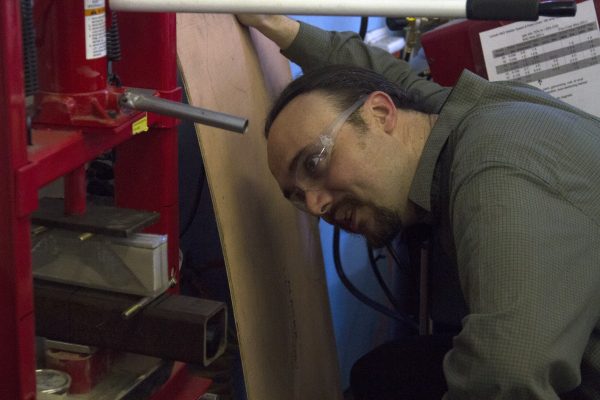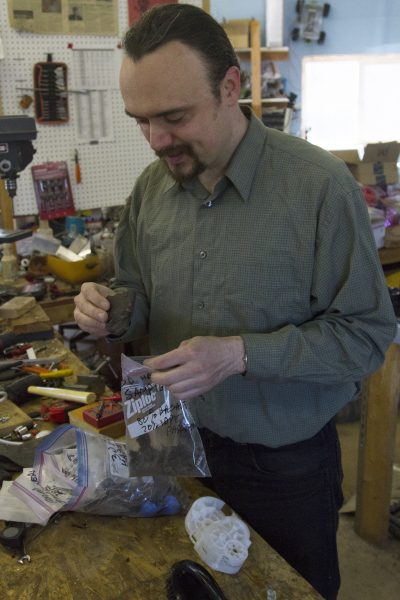UAF's Lawlor earns NASA prize in Mars habitat contest
May 31, 2017
Jeff Richardson
907-474-6284

Download text and photo captions here.
In a cramped workshop at his home near Fox, Orion Lawlor is working to develop the technology that could someday allow people to live on Mars.
Lawlor’s creations are modest — small plastic beams and thin, hollow cylinders that can be filled with powdered rock. But items like those, which are created by his one-of-a-kind 3-D printer, may eventually become the components for creating habitat in space.
The creations earned Lawlor, an associate professor of computer science at the University of Alaska Fairbanks, a winning entry in the most recent phase of NASA’s 3D-Printed Habitat Challenge in May. That included a prize of $14,070 from the U.S. space agency, which is seeking innovative ways to build structures on distant planets.
Lawlor was one of only two winners in the first phase of the global competition, even though he has no background in architecture or civil engineering. The other was Foster + Partners, a multinational architecture firm.
“I’m certainly working outside my area,” Lawlor said with a smile. “I pretty much write code for a living.”
Despite that inexperience as a builder, Lawlor said he was intrigued after hearing about the NASA challenge last fall. He taught a robotics and 3-D printing course at UAF a few years ago, and got some construction advice from UAF student Alexander Medeiros, who graduated this spring with a mechanical engineering degree.
Lawlor’s homemade 3-D printer, called the Alaska90, is a monument to do-it-yourself construction. The device, which he designed on a computer, mainly includes components made by a smaller 3-D printer. They work alongside improvised materials such as steel rods from a foosball handle, a large plastic funnel and reused vitamin containers hanging from strings.
The competition is rooted in the reality of lengthy space missions: Astronauts probably won’t have the luxury of bringing many building materials on a long, expensive journey.
“We’ve done space exploration where you bring it all — food, water, everything — but NASA has realized that’s just not sustainable,” Lawlor said.
Instead, the foundation of the NASA contest is to use what’s available when astronauts arrive at their destination, using a 3-D printer as a primary building tool. That involves crushed basalt dust, which would probably be abundant on the surface of a moon or planet, and the leftover plastic food packaging that would be needed to supply a ship’s crew on a six-month trip to Mars. Resources on Mars could conceivably be used to make additional plastics after astronauts were settled. The contest requires the use of at least 70 percent rock dust and as much as 30 percent plastic in the designs.
For his entry in the competition, Lawlor used computer software to design a large 3-D printer, then made its components with a smaller printer. He said much larger “scaled up” designs capable of printing buildings could be made by repeating that process over and over.
The next phases of the NASA competition will come later this summer, including the design and construction of a load-bearing 3-D printed beam. The lessons learned from those efforts will ultimately be used to build a near 5-foot-wide dome during a head-to-head competition in Illinois in September.

The project could also have applications much closer to home. One of the sponsors of the NASA competition is the machinery company Caterpillar, which is intrigued by the possibilities of 3-D printed construction. In a webinar outlining the rules of the competition, Caterpillar producer Mike Dimmick said the competition could have implications for building both on distant planets and here on Earth.
“We think this is a chance to be part of something truly exciting and also truly forward thinking,” Dimmick said.
Lawlor is skeptical that any of his designs will be directly sent to Mars someday, but he is excited to be part of a competition that could help build and tune the technology needed to reach that goal. After studying the issue, he said using automation to create buildings on Mars feels like it could be possible soon.
The project meshes well with an unrelated NASA project Lawlor has been working on with a group of students. They’re creating a robotic vehicle that will mine dust, which could become the key ingredient in building materials on Mars.
“It actually seems surprisingly plausible to be building infrastructure up there,” he said.


